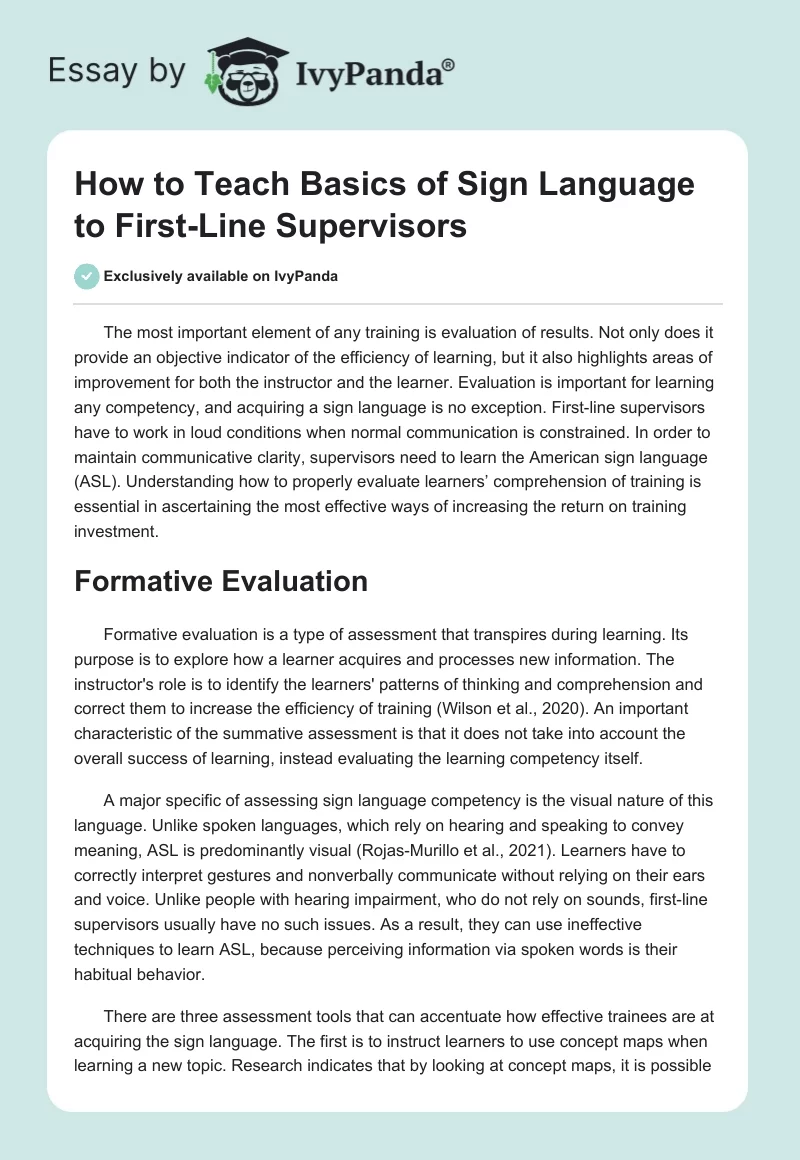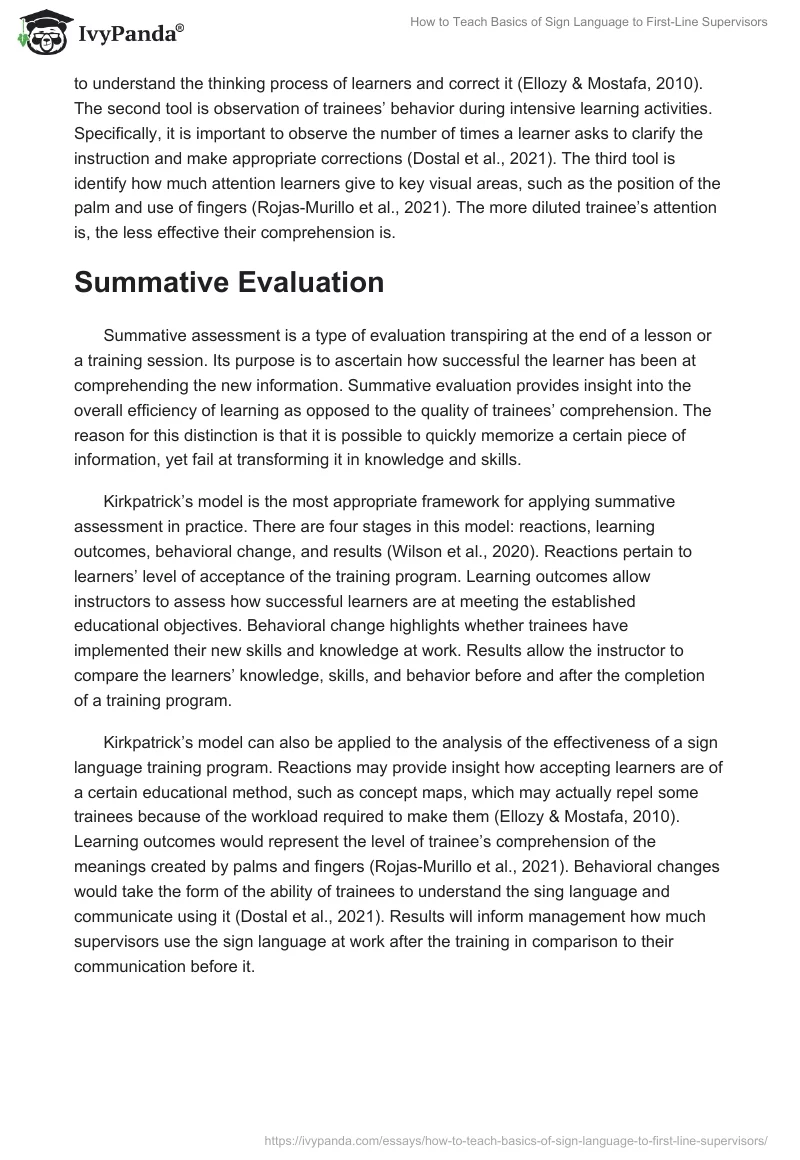The most important element of any training is evaluation of results. Not only does it provide an objective indicator of the efficiency of learning, but it also highlights areas of improvement for both the instructor and the learner. Evaluation is important for learning any competency, and acquiring a sign language is no exception. First-line supervisors have to work in loud conditions when normal communication is constrained. In order to maintain communicative clarity, supervisors need to learn the American sign language (ASL). Understanding how to properly evaluate learners’ comprehension of training is essential in ascertaining the most effective ways of increasing the return on training investment.
Formative Evaluation
Formative evaluation is a type of assessment that transpires during learning. Its purpose is to explore how a learner acquires and processes new information. The instructor’s role is to identify the learners’ patterns of thinking and comprehension and correct them to increase the efficiency of training (Wilson et al., 2020). An important characteristic of the summative assessment is that it does not take into account the overall success of learning, instead evaluating the learning competency itself.
A major specific of assessing sign language competency is the visual nature of this language. Unlike spoken languages, which rely on hearing and speaking to convey meaning, ASL is predominantly visual (Rojas-Murillo et al., 2021). Learners have to correctly interpret gestures and nonverbally communicate without relying on their ears and voice. Unlike people with hearing impairment, who do not rely on sounds, first-line supervisors usually have no such issues. As a result, they can use ineffective techniques to learn ASL, because perceiving information via spoken words is their habitual behavior.
There are three assessment tools that can accentuate how effective trainees are at acquiring the sign language. The first is to instruct learners to use concept maps when learning a new topic. Research indicates that by looking at concept maps, it is possible to understand the thinking process of learners and correct it (Ellozy & Mostafa, 2010). The second tool is observation of trainees’ behavior during intensive learning activities. Specifically, it is important to observe the number of times a learner asks to clarify the instruction and make appropriate corrections (Dostal et al., 2021). The third tool is identify how much attention learners give to key visual areas, such as the position of the palm and use of fingers (Rojas-Murillo et al., 2021). The more diluted trainee’s attention is, the less effective their comprehension is.
Summative Evaluation
Summative assessment is a type of evaluation transpiring at the end of a lesson or a training session. Its purpose is to ascertain how successful the learner has been at comprehending the new information. Summative evaluation provides insight into the overall efficiency of learning as opposed to the quality of trainees’ comprehension. The reason for this distinction is that it is possible to quickly memorize a certain piece of information, yet fail at transforming it in knowledge and skills.
Kirkpatrick’s model is the most appropriate framework for applying summative assessment in practice. There are four stages in this model: reactions, learning outcomes, behavioral change, and results (Wilson et al., 2020). Reactions pertain to learners’ level of acceptance of the training program. Learning outcomes allow instructors to assess how successful learners are at meeting the established educational objectives. Behavioral change highlights whether trainees have implemented their new skills and knowledge at work. Results allow the instructor to compare the learners’ knowledge, skills, and behavior before and after the completion of a training program.
Kirkpatrick’s model can also be applied to the analysis of the effectiveness of a sign language training program. Reactions may provide insight how accepting learners are of a certain educational method, such as concept maps, which may actually repel some trainees because of the workload required to make them (Ellozy & Mostafa, 2010). Learning outcomes would represent the level of trainee’s comprehension of the meanings created by palms and fingers (Rojas-Murillo et al., 2021). Behavioral changes would take the form of the ability of trainees to understand the sing language and communicate using it (Dostal et al., 2021). Results will inform management how much supervisors use the sign language at work after the training in comparison to their communication before it.
Assumptions
In order to calculate the return on investment, a number of assumptions have to be made regarding the cost of training and risks. The first one is that the inability to communicate using the sign language is the reason behind many accidents involving first-line workers. The second assumption is that the annual fee paid to the training provider is $3,500, while travel costs for trainees are $6,500 (Andrews & Laing, 2018, p. 6). The second assumption is that annual plant maintenance costs $1,000,000 a year. The final assumption is that once supervisors learn the sign language, the cost of maintenance is lowered by $100,000.
Return on Investment
The ultimate goal of any organization is to maximize benefits while reducing costs. Financing employee training is a significant investment, which has to pay out in the long-term perspective. The formula for return on investment is ROI = Benefits/Costs. The total cost including both trainer fees and travel costs would be $10,000, which is calculated by adding $3,500 to $6,500. Combined with the $1,000,000 required for annual plant maintenance, the total cost is $1,010,000. In the year, where training is scheduled the benefits are $100,000. If a company continues to schedule training courses each year, the benefits will outweigh the costs in ten years. The numerical indicator of such a change would be the value of 1 achieved when the benefits are divided by costs.
The first change that could improve ROI is selecting a training provider that is located in closer proximity to minimize travel costs. The second change is to observe the reactions of trainees to mind maps – if developing concept maps takes more time than actually learning the sign language, they should be replaced with a more traditional material. The third change is to add smaller summative assessments during the training, which could take the form of quick evaluations of learners’ comprehension of the material at the beginning of each lesson (Dostal et al., 2021). Combined, these measures can reduce the costs and improve the quality of training.
Conclusion
Altogether, it should be evident that summative and formative evaluations are not exclusive and can be used in combination. Some learning techniques may cause negative reactions in trainees, requiring instructors to use a different assessment tool. Meanwhile, regular assessment on a smaller scale may help instructors understand how quickly trainees progress in learning the sign language. Ultimately, the goal is to ensure that supervisors can communicate using only gestures at work, rather than configuring the most coherent assessment of a sign language training program.
References
Andrews, P., & Laing, G. (2018). Evaluating the outcomes of a training program through an ROI evaluation: A case study. e-Journal of Social & Behavioural Research in Business, 9(3), 1-9.
Dostal, H. M., Scott, J. A., Weir, J., Kang, K. Y., Amadi-Ihebuzor, C., & Bernard, T. A. (2021). Literacy development at camp: Leveraging language models. The Reading Teacher, 74(5), 539-547. Web.
Ellozy, A. R., & Mostafa, H. M. (2010). Making learning visible: Using e-maps to enhance critical reading skills. MERLOT Journal of Online Learning and Teaching, 6(3), 634-646.
Rojas-Murillo, S., Pancho, A. B., Cariaso, M. J., Speicher, A., Mato, A., & Segal, O. (2021). Visual learning curves for American sign language (ASL) alphabet. International Journal of Industrial Ergonomics, 81, 1-15. Web.
Wilson, M., Sahay, S., & Calhoun, C. (2020). Addie explained: Evaluation. aritzhaupt.com. Web.


